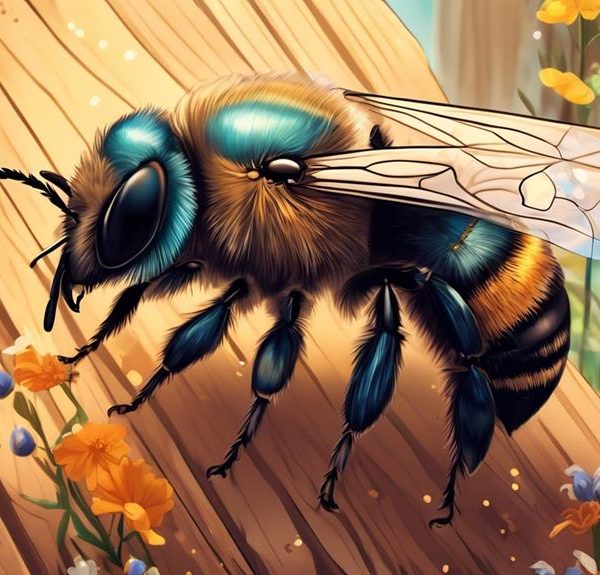Yes, mason bees may buzz around your garden, but are they really as dangerous as they seem? Discover the surprising truth.
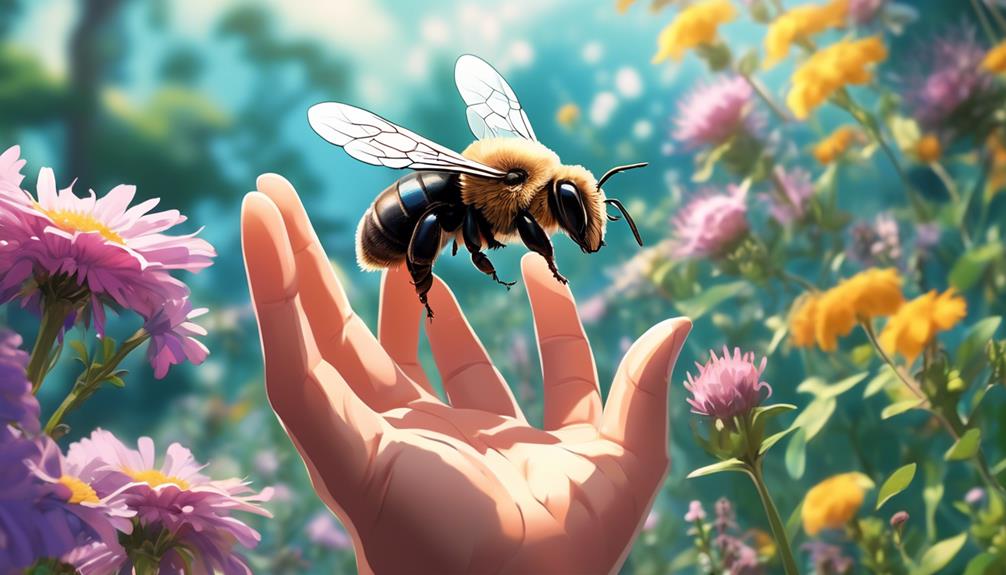
Are Mason Bees Dangerous
While you might think of bees as the marauding Vikings of the insect world, buzzing about creating havoc and stinging at will, there's one variety that doesn't quite fit the bill – the mason bee.
You've likely seen them at work in your garden, but are these diligent pollinators truly as dangerous as their reputation suggests?
As we explore the behavior, life cycle, and human interaction of these bees, we'll also dispel some common myths about them.
So, buckle up for a fascinating journey into the world of mason bees, where things are not always as they seem.
Key Takeaways
- Mason bees are not aggressive or dangerous.
- They rarely sting unless directly threatened.
- Mason bees are incredibly efficient pollinators, equivalent to 100 honeybees.
- They do not damage wooden structures like carpenter bees.
Understanding Mason Bees

Diving into the world of Mason Bees, you'll find that these insects are solitary creatures, known scientifically as Osmia, and possess unique characteristics that set them apart from other bee species. Unlike their honeybee siblings, Mason bees don't live in colonies, nor do they produce honey. They're named after their unique nesting behavior; they utilize mud or clay (like a mason would) to build their nests in crevices or hollow stems.
You'll also notice that Mason bees are more docile than honeybees. They don't have a hive or queen to protect, so they're less likely to sting unless provoked. Even then, their sting is far less painful than that of a honeybee.
In terms of appearance, Mason bees differ from honeybees in that they're typically metallic blue or green, with a robust body form. They're also efficient pollinators, often preferred for fruit tree pollination. Their solitary nature means they're less likely to spread disease or parasites within their species.
Understanding these differences can help you appreciate the Mason bee not as a threat, but as an essential part of the ecosystem. You'll find that they're far from dangerous, and are actually quite beneficial.
Mason Bees Vs. Other Bees
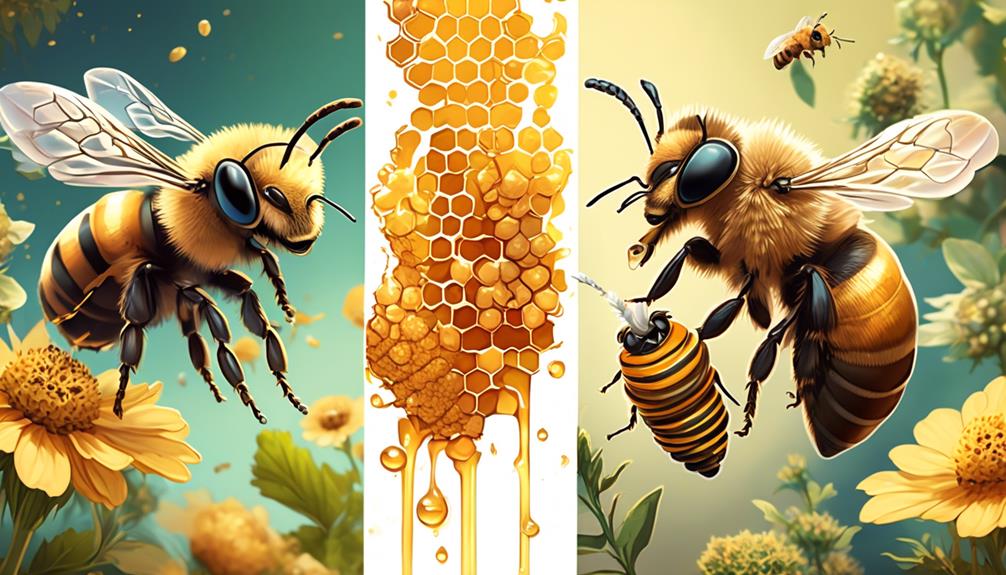
Continuing our exploration, let's compare Mason bees to other bee species, emphasizing their unique traits and the crucial roles they play in our ecosystem.
Unlike Honey Bees, Mason Bees are solitary; each female is fertile and makes her own nest. They don't produce honey or beeswax, focusing instead on pollination.
Due to their solitary nature, Mason Bees are less defensive and rarely sting, unless trapped or squeezed. On the contrary, social bees like Honey Bees and Bumblebees tend to be more aggressive due to hive protection instinct.
Analyzing their pollination efficiency, Mason Bees stand out. A single Mason Bee can pollinate as much as 100 Honey Bees. They're voracious pollinators, even in cold or drizzly weather, when Honey Bees are less active.
Their nesting habits differ too. Mason Bees prefer small holes or tubes, often utilizing cracks in wood or hollow stems. They seal each nesting chamber with mud, hence the name. Honey Bees, however, live in large colonies in hives.
Understanding these differences can help you appreciate the diversity and balance in nature, and the importance of each species in our ecosystem.
The Life Cycle of Mason Bees
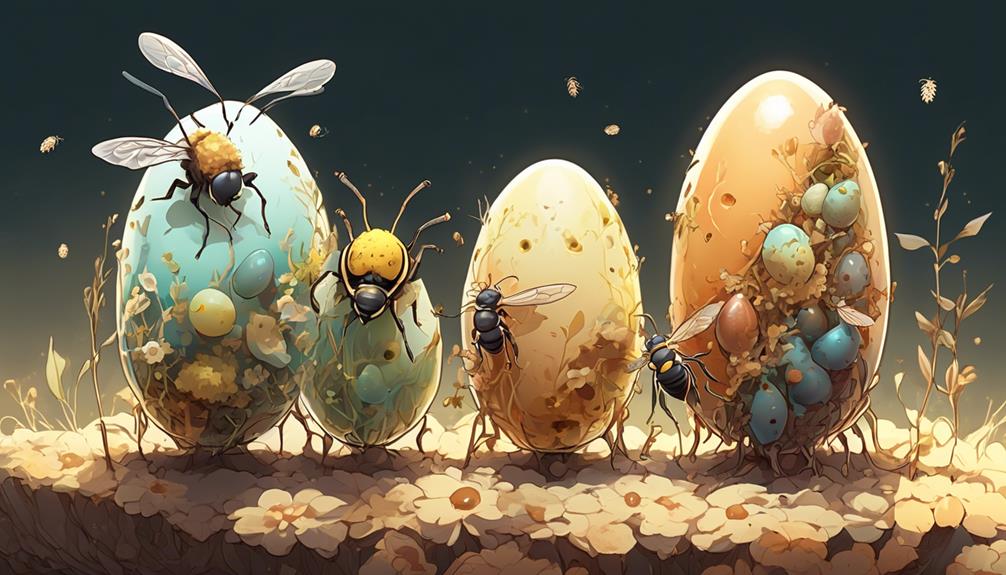
To fully appreciate the role of Mason Bees in our ecosystem, let's delve into their fascinating life cycle, marked by distinct phases and unique behaviors. Just like other bees, they undergo a complete metamorphosis, transitioning from egg to larva, then pupa, and finally, adult.
Here's a simple breakdown of a Mason Bee's life cycle:
Stage | Duration |
|---|---|
Egg | 1-2 weeks |
Larva | 6-8 weeks |
Pupa | 9-11 weeks |
Adult | 3-4 weeks |
Once the female lays her eggs in a hollow tube or crevice, she supplies each with a ball of pollen and nectar as nourishment, then seals the chamber with mud. This is how they get their 'mason' name. The eggs hatch into larvae, which feed on the provided nourishment until they pupate. After several weeks, the adult bees emerge.
The life span of adult Mason Bees is relatively short, typically just a few weeks. Despite their brief existence, these industrious insects play a vital role in our ecosystem, particularly in pollination. Understanding their lifecycle helps you appreciate their importance and dispel any fears.
Mason Bees and Human Interaction

When interacting with Mason Bees, you'll quickly notice that they're more docile than their honeybee counterparts, showing a remarkable indifference to human presence unless directly threatened. Their passive demeanor stems from their solitary nature, focusing primarily on foraging and nest-building rather than hive defense.
Unlike honeybees, Mason Bees lack a barbed stinger, and although capable of stinging, they rarely do so unless squeezed or stepped on. Even then, the sting's effect on humans is minimal, rarely causing more than a mild, localized discomfort. They're not known to cause severe allergic reactions, unlike some other bee species.
You may also observe that they're incredibly efficient pollinators, with a single Mason Bee capable of doing the work of 100 honeybees. As such, they're often welcomed by gardeners and farmers seeking to boost crop yield.
Lastly, you'll find that these bees aren't typically attracted to human food or sweet drinks. They're instead drawn to nectar and pollen, making them less of a nuisance at outdoor gatherings.
To summarize, Mason Bees are largely harmless to humans and can even prove beneficial in certain situations. However, like all wildlife, they should be respected and not handled unnecessarily.
Dispelling Mason Bee Myths
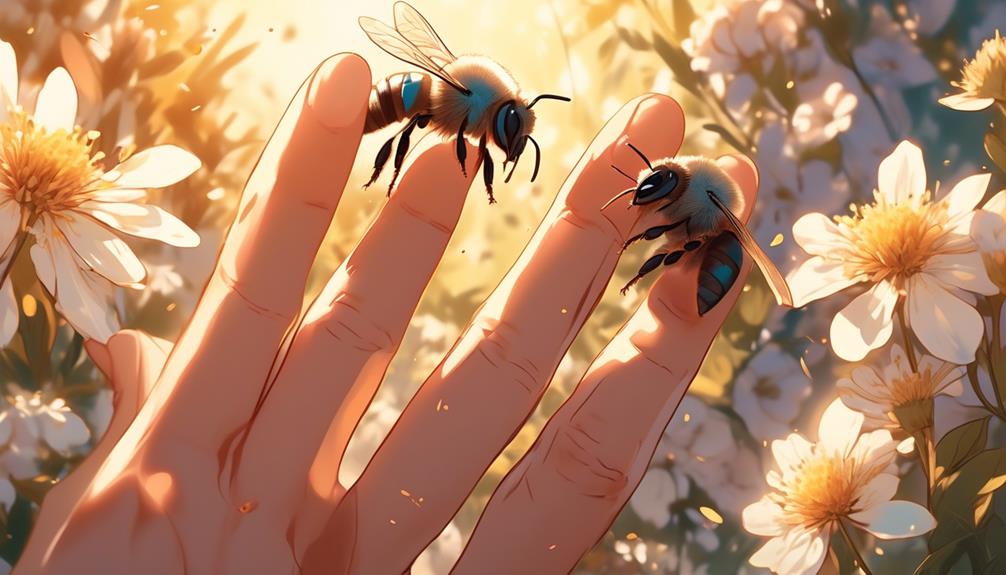
Let's debunk some common myths about Mason Bees to better understand their behavior, role in our ecosystem, and their perceived threat to humans.
One common misconception is that Mason Bees are aggressive and dangerous. In truth, these insects are solitary and non-aggressive, preferring to focus on pollination rather than defending a hive.
Another fallacy is that Mason Bees sting. While technically they can, they only do so when threatened or squashed. Even then, their sting is mild and far less painful than that of other bee species. Females possess the stinger, but rarely use it, as they're more interested in foraging.
The third myth is that Mason Bees damage wooden structures. Mason Bees don't chew wood like carpenter bees. They use existing holes for nests, doing no harm to your property.
Lastly, many believe these bees are pests. This couldn't be further from the truth. Mason Bees are vital pollinators, significantly boosting crop yields. They're nature's little helpers, not nuisances.
Frequently Asked Questions
What Type of Habitats Do Mason Bees Prefer?"
You're wondering about mason bees and their preferred habitats. Well, they aren't picky. They'll settle in clumps of reeds, hollow stems, or holes in wood.
They're solitary creatures, so they don't need a hive like honeybees. They're also great at adapting to urban environments, so don't be surprised if you see them nesting in cracks in your brickwork.
They're just looking for a safe, snug space to lay their eggs.
What Are the Main Threats to Mason Bees in the Wild?"
No, mason bees aren't dangerous. They're non-aggressive and only sting when threatened. Even if stung, their sting is less painful than a mosquito bite.
They're actually beneficial for pollination. Don't let their buzzing frighten you, they're more interested in flowers than humans. So, if you see them in your garden, let them be.
They're doing important work and pose no threat to you or your family.
Can Mason Bees Be Kept for Honey Production?"
No, you can't keep mason bees for honey production. They're solitary bees, not honeybees. They don't live in hives or produce honey. They're important for pollination, not honey production.
Their focus is on providing for their offspring, not creating surplus honey. So, if you're interested in having bees for honey, mason bees wouldn't be your best choice.
They're great for helping your garden flourish, though!
How Can One Attract Mason Bees to Their Garden?"
You're looking to attract Mason bees to your garden, right?
It's actually quite simple. Start by providing them with a suitable habitat, like a bee house with small tubes or holes.
They're also attracted to a variety of flowering plants, so consider planting some in your garden.
Don't forget to provide a mud source, they need it for their nests.
Keep pesticides to a minimum, as they can be harmful to the bees.
Good luck!
How Does Climate Change Affect Mason Bees?"
Climate change can significantly impact mason bees. As you might know, these bees are sensitive to temperature changes. When the climate warms, it can disrupt their hibernation cycles, causing them to emerge before plants have bloomed. This means they can't find the pollen they need to survive.
Additionally, more frequent and severe weather events can damage their habitats. So, yes, climate change can pose a serious threat to mason bees.
Conclusion
So, are mason bees dangerous? Absolutely not. They're essential pollinators, not aggressive stingers. Their lifecycle is fascinating, and interacting with them is typically harmless.
Don't let misconceptions scare you away from these industrious insects. Understanding and respecting mason bees encourages a healthier ecosystem. So, instead of fearing them, appreciate their vital role in our environment.
Remember, every bee, including the mason bee, plays a crucial part in our world.


